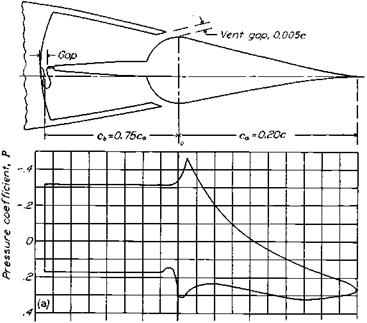Internally Balanced Controls
Another control surface balance type that appeared about the same time as beveled controls was the internally balanced control. This control is called the Westland-Irving internal balance in Great Britain. Internally balanced controls are intended to replace the external aerodynamic balance, a source of wing drag because of the break in the wing contour. In the internally balanced control the surface area ahead of the hinge line is a shelf contained completely within the wing contour (Figure 5.12). Unless the wing is quite thick and has its maximum thickness far aft, mechanical clearance requires either that the shelf be made small, restricting the available amount of aerodynamic balance, or control surface throws be made small, restricting effectiveness.
By coincidence, internally balanced controls appeared about the same time as the NACA 65-, 66-, and 67-series airfoil sections. These are the laminar flow airfoils of the 1940s and 1950s. Internally balanced ailerons are natural partners of laminar flow airfoil sections, since aerodynamic balance is obtained without large drag-producing surface cutouts for the overhang. Not only that, but the 66 and 67 series have far aft locations of wing maximum thickness. This helps with the clearance problem of the shelf inside of the wing contour.
|
Figure 5.12 The internally balanced control surface, used to reduce drag by eliminating the wing cutouts needed with overhang aerodynamic balances. Pressures at the upper and lower vent gaps are delivered to the sealed chamber, balancing the surface about its hinge. Pressure coefficients shown are for a 5-degree down-surface deflection. (From Toll, NACA Rept. 868, 1947) |
An internal balance modification that gets around the mechanical clearance problem on thin airfoils is the compound internal balance. The compound shelf is made in two, or even three, hinged sections. The forward edge of the forward shelf section is hinged to fixed airplane structure, such as the tail or wing rear spar (Figure 5.13). The first application of the compound internal balance appears to have been made by William H. Cook, on the Boeing B-47 Stratojet. Internally balanced elevators and the rudder of the Boeing B-52 have compound shelves on the inner sections of the control surfaces and simple shelves on the outer sections.
Compound internal balances continue to be used on Boeing jets, including the 707, 727, and 737 series. The 707 elevator is completely dependent on its internal aerodynamic balance; there is no hydraulic boost. According to Cook, in an early Pan American 707, an inexperienced co-pilot became disoriented over Gander, Newfoundland, and put the airplane into a steep dive. The pilot, Waldo Lynch, had been aft chatting with passengers. He made it back to the cockpit and recovered the airplane, putting permanent set into the wings. In effect, this near-supersonic pullout proved out the 707’s manual elevator control. The 707’s internally balanced ailerons are supplemented by spoilers, as described in Chapter 19, “The Elastic Airplane.”
The later Boeing 727 used dual hydraulic control on all control surfaces, but internal aerodynamic balance lightens control forces in a manual reversion mode. An electrically driven adjustable stabilizer helps in manual reversion. At least one 727 lost all hydraulic power and made it back using manual reversion.
Internally balanced controls were used on a number of airplanes of the 1940s and 1950s. The famous North American P-51 Mustang had internally balanced ailerons, but they were unsealed, relying on small clearances at the front of the shelf to maintain a pressure
|
Figure 5.13 Simple and two-element compound internal aerodynamic balances on the Boeing B-52 elevator. The compound balance segment is inboard. (From B-52 Training Manual, 1956) |
differential across the shelf. The Curtiss XP-60 and Republic XF-12 both used internally balanced controls, not without operational problems on the part of the XP-60. Water collected on the seal, sometimes turning to ice.















